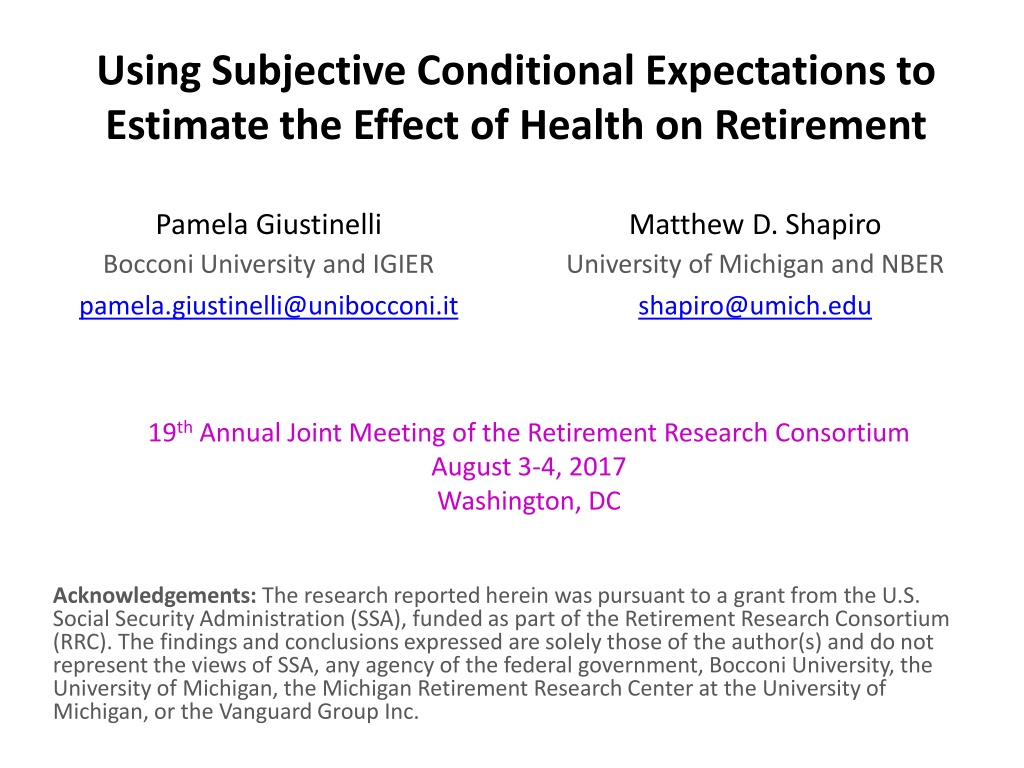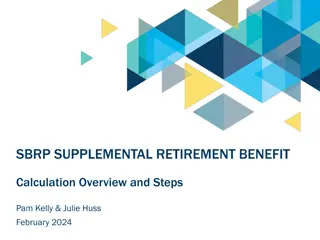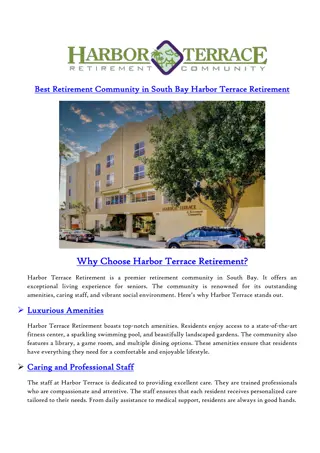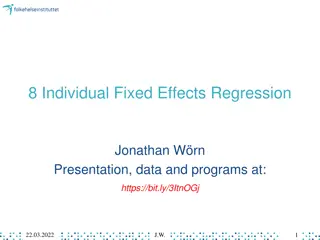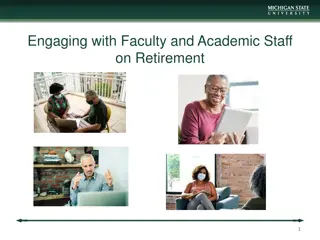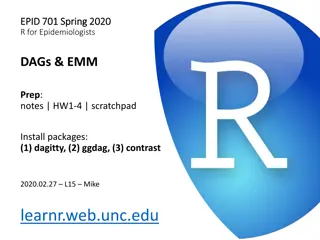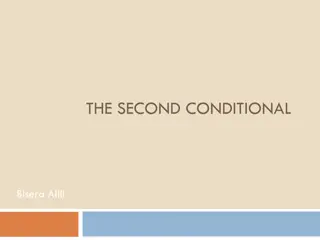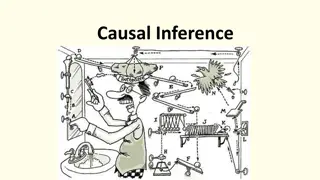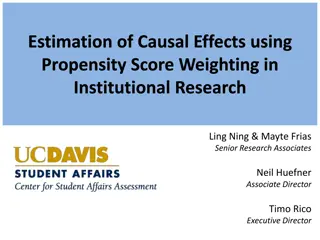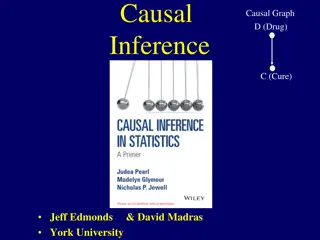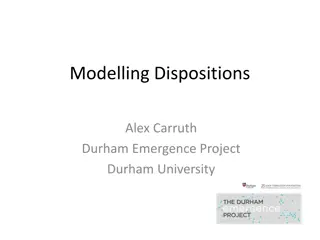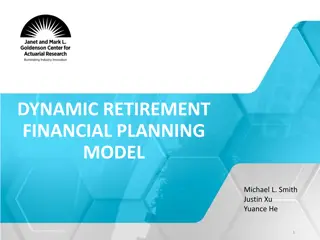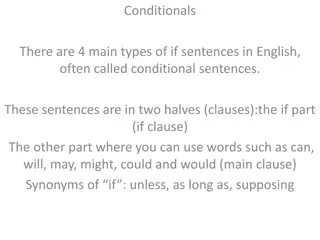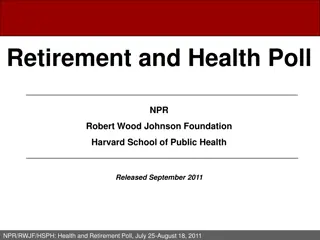Causal Effects of Health on Retirement Using Subjective Conditional Expectations
This research explores the impact of health on retirement decisions by analyzing subjective conditional expectations of older workers. By studying the relationship between health, work, and retirement planning, the study aims to provide insights into policy implications for ensuring the future solvency of social security programs. The analysis includes simulations of how changes in health distribution could affect labor supply forecasts over specified time horizons.
Download Presentation

Please find below an Image/Link to download the presentation.
The content on the website is provided AS IS for your information and personal use only. It may not be sold, licensed, or shared on other websites without obtaining consent from the author. Download presentation by click this link. If you encounter any issues during the download, it is possible that the publisher has removed the file from their server.
E N D
Presentation Transcript
Using Subjective Conditional Expectations to Estimate the Effect of Health on Retirement Pamela Giustinelli Bocconi University and IGIER pamela.giustinelli@unibocconi.it Matthew D. Shapiro University of Michigan and NBER shapiro@umich.edu 19th Annual Joint Meeting of the Retirement Research Consortium August 3-4, 2017 Washington, DC Acknowledgements: The research reported herein was pursuant to a grant from the U.S. Social Security Administration (SSA), funded as part of the Retirement Research Consortium (RRC). The findings and conclusions expressed are solely those of the author(s) and do not represent the views of SSA, any agency of the federal government, Bocconi University, the University of Michigan, the Michigan Retirement Research Center at the University of Michigan, or the Vanguard Group Inc.
Motivation The future solvency of the U.S. Social Securityprogram is threatened by projected costs exceeding revenues. Increasing retirement age requires that workers have the health capacity to work longer. We provide a novel strategy: To quantify the causal relationship between health and work; To simulate the effects of hypothetical changes to the health distribution of older workers on the population s labor supply forecasts at specified horizons.
Research Questions 1. Will healthy older workers have the health capacity to work in 2 and 4 years? 2. Will healthy older workers work in 2 and 4 years? 3. What is the causal effect of health on work for these workers? 4. How would population-level forecasts of labor supply at 2 and 4 years change, if the probability of low health at those horizons was halved?
Approach We use novel survey data on work and health expectations of healthy older workers participating in the Vanguard Research Initiative (VRI). In the 2015 VRI, these Rs were asked the likelihood (on a 0- 100% chance scale) that they will be working to specified horizons (2 and 4 years) under alternative health scenarios ( high and low. ) They also reported their unconditional likelihoods of working to those horizons and of entering those health states.
Example of Survey Questions Unconditional working probability What are the chances that you will be working for pay 2 [or 4] years from now? [fill-in box]% Unconditional health probability What are the chances that your health will be good 2 [or 4] years from now? [fill-in box]% Conditional working probability given health If your health is good 2 [or 4] years from now, what are the chances that you will be working for pay? [fill-in box]%
Vanguard Research Initiative (VRI) The VRI is a survey-administrative linked dataset on older wealthholders. Rs are account holders at Vanguard with $10,000+ in financial assets, aged 55+, and web-survey eligible. Approx. 3,000 Rs have completed four surveys, each on a different aspect of retirement decision-making: (S1) Wealth; (S2) Long-term Care; (S3) Transfers; (S4) Labor. Our analysis is based on (S4), but uses covariates from all four surveys.
Analytic Sample Sample Selection Respondents who: 1) took the first 4 surveys; 2) were working in a career or bridge job at S4; 3) gave complete and consistent responses to the expectations battery; 4) reported being in high health (E, VG, or G) in S4. Analytic Sample(s) 1. 2-year sample: 970 Rs, 57-81, working and in high health. 2. 4-year sample: 839 Rs from sample 1, who reported a positive probability of working in 2 years.
Question 1: Health Projections in 4 Years 4-Year Ahead P(Health) P(Low) 24% P(High) 76%
Question 2: Labor Supply Projections in 4 Years 4-Year Ahead P(Work) P(Retire) 47% P(Work) 53%
Work & Health Projections in 4 Years 4-Year Ahead P(Work, Health) P(Retire, High) 31% P(Work, High) 46% P(Retire, Low) 16% P(Work, Low) 7%
What if Everyone Were in High Health in 4 Years? Counterfactual P(Work) if All in High Health in 4 Years P(R| H) 41% P(W | H) 59%
What if Everyone Were in Low Health in 4 Years? Counterfactual: P(Work) if All in Low Health in 4 Years P(W | L) 33% P(R | L) 67%
Question 3: Average Subjective Ex Ante Treatment Effect (ASATE) of Health on Work 4-Year Ahead ASATE P(W | L) 33% P(R | H) 41% |ASATE| 26%
Question 4: What if the Chances of Low Health Halved? (I) 4-Year Ahead P(Health), Survey Simulation, Probability of Low Health Halved P~(L) 12% P(L) 24% P~(H) 88% P(H) 76%
Quest. 4: What if the Chances of Low Health Halved? (II) 4-Year Ahead P(Work), Survey Simulation, P(Work) if Low Health Halved P(R) 47% P~(R) 44% P(W) 53% P(W) 53% Delta P(W) 3%
Conclusion New method for quantifying the effect of health on work at the individual and aggregate levels. Population-level forecasts of the labor supply at specific horizons under hypothetical scenarios about the population health distribution. The effect of health on work economically sizeable, but only a fraction of what determines retirement. Subjective ex ante treatment effects (SATE) large, but Most older workers expect to retire before risk of bad health gets high.
Extensions Our method can be extended to: quantify the importance of other determinants of labor supply (e.g., availability of work, financial resources, etc.); disentangle different health mechanisms (e.g., disutility, wages, medical expenses, etc.). Our estimates could be used to bound the effect of increasing the normal retirement age based on health. Our estimates can serve as inputs into structural modeling, where the conditional working expectations are used as direct measures of the conditional probabilities generated by a behavioral dynamic model of labor supply (in progress).
Additional Data 2017 VRI (planned) Realizations of health and labor supply for panel. Repeat conditional expectations questions for health. Added conditional expectations questions. 2016 HRS experimental module Same questions as 2015 VRI (data available soon). SATE estimates on a more varied sample of older Americans.
Thank you! pamela.giustinelli@unibocconi.it shapiro@umich.edu
